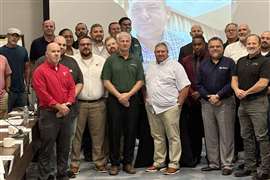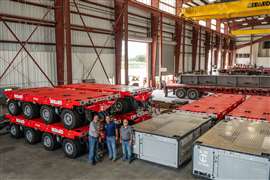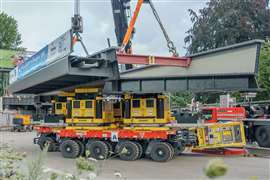Return shuttle
01 May 2008

Even though it was the 50th time a shuttle had been prepared, lifted and secured atop a 747 aircraft and then ferried across the country, the task is still complicated. NASA prefers to land the shuttle where it is launched–in Florida–mainly because of the expense of getting the craft home; the August hoist and haul operation cost close to $1 million.
The shuttle's journey back to Florida began about a week after it landed, according to Casey Wood, post landing test conductor. The most time–consuming operation was draining and purging the fuels and chemicals from the shuttle and readying it for the homeward flight.
Lifting and placing the craft atop the aircraft took about 18 hours and involved around 35 people and the specially designed Shuttle Mate/Demate Device (MDD). The MDD at NASA's Dryden Flight Research Center in Edwards, CA is a large gantry structure used in post-landing servicing and in securing the shuttle atop the Boeing 747 Shuttle Carrier. It was last used in 2002.
The MDD gantry is two 100–foot towers with work platforms every 20 feet, from 20 to 80 feet on each tower, and a horizontal structure mounted at the 80 foot level between the two towers. The horizontal unit cantilevers 70 feet out from the main towers and guides a lift beam system that attaches to the shuttle at four points. Th ree hoists are used to raise and lower the lifting beam. Two of the hoists are connected to the aft portion of the beam with the other attached to the forward section. Each hoist has a lifting capacity of 100,000 pounds and all three operate simultaneously. Operating together, the total safe lifting capacity of the three units is 240,000 pounds or 120 tons. (The average space shuttle weighs 231,000 pounds, although this one weighed exactly 227,182 pounds, Wood said.)
During the Discovery turnaround operation in August, an access platform was positioned on each side of the shuttle after it was towed into the MDD. The platforms are normally stored at the 60–foot level when out of use and lowered during servicing.
Once the shuttle was ready for mating with the 747, the lifting beam was attached to the three hoists. The hoists then slowly lifted Discovery about 60 feet of the ground.
The 747 was rolled in under the shuttle, which was then lowered to about the 45 to 50 foot level, before being secured to the plane. “The aft is secured with the same technology that is used to connect the shuttle to the external fuel tank, except there are no pyrotechnical bolts,” said Wood. After securing the shuttle the hoists and lifting gear were detached and the two mated aircraft were towed out of the MDD.
The crane alternative
Had the shuttle landed in White Sands, NM, the shuttle would have been placed atop the 747 using the lifting sling and two conventional cranes.
“We did that one time, for STS–3,” Wood explains. “We were prepared for that if it had landed there this time. We actually have mated shuttles that way several times, when we took it to Paris for the World's Fair and other times it has been on display. The same sling is used. The difference is lifting with cranes rather than using the hoists.”
Once the shuttle got back to Florida the two mated planes were “demated” in a similar MDD at the Johnson Space Center. “We just reversed the process,” concluded Wood.
Tower testing
In a NASA fact sheet about the MDD, retired MDD inspector Ski Markey remembers testing the device soon after it was built. “To make sure the weight of the shuttle would not pull the MDD out of the ground, we had three concrete blocks that simulated the shuttle's weight. It looked good to us,” he said.
Connell Associates of Coral Gables, FL, designed the MDD, which was constructed in 1976 by George A Fuller for $1.7 million. Back in late 2003, the MDD at Dryden underwent a dramatic $2 million, year–long overhaul involving removal of the old, lead–based paint and repainting. The 240 tons of lead–based paint was recycled rather than put into land?ll. Th rough the years, as the space shuttle has evolved, the MDD has been altered, requiring additional welding, more work platforms and higher lift capacity. The replacement value of the MDD has been estimated at around $9 million.
STAY CONNECTED


Receive the information you need when you need it through our world-leading magazines, newsletters and daily briefings.
CONNECT WITH THE TEAM











